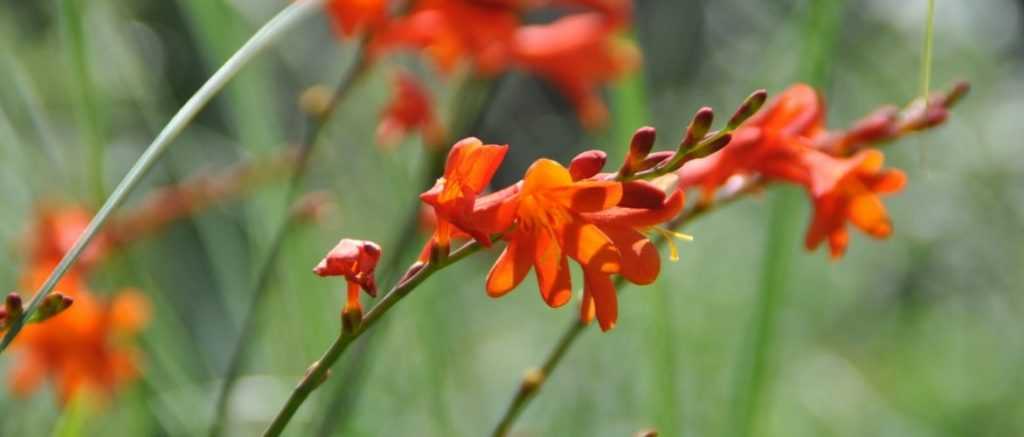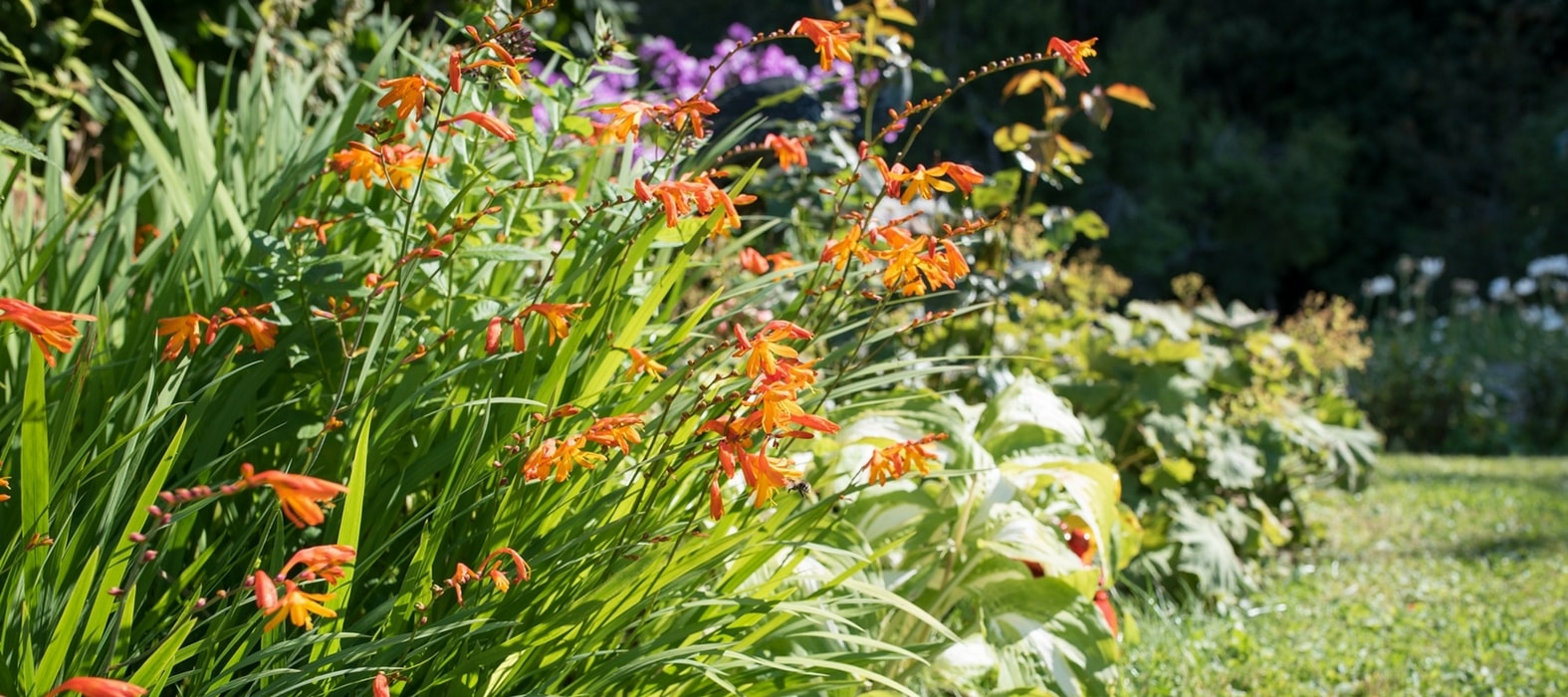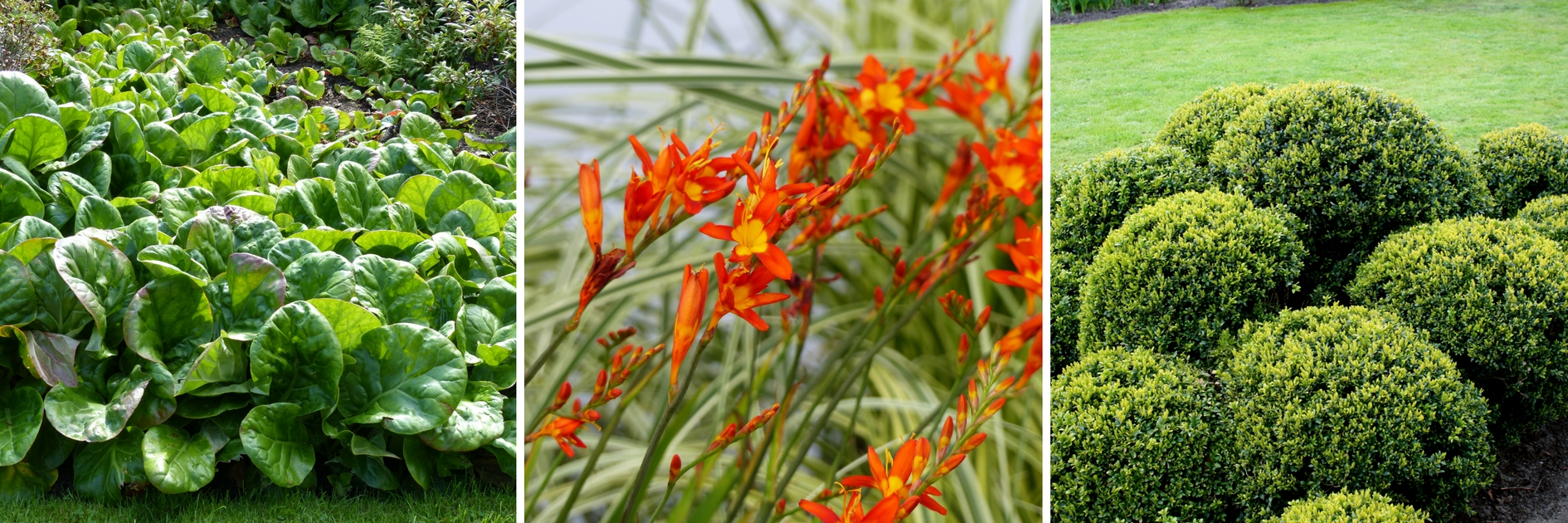
Crocosmia or Montbretia: 9 Planting Combination Ideas
for a garden with vibrant colours
Contents
With its vibrant colours, the crocosmia warms up the garden, adding a touch of exoticism. The yellow-orange-red tones bring a warm and lively feel to flower beds! These are bright, luminous, and joyful colours. Crocosmia can thus be used to create a splash of colour that immediately catches the eye and guides visitors through the garden. Red varieties, such as ‘Lucifer’, are better suited to larger gardens, as this colour reduces distances. We recommend planting them in groups of 10 to 15 bulbs for a stronger visual impact and to enhance the “splash of colour” effect.
The vivid colours of crocosmia make it easy to integrate into an exotic-themed flower bed. Pair it with plants featuring exuberant foliage and brightly coloured blooms (Cannas, Castor Beans, etc.). You can also play with colours by pairing it with plants in warm tones or opting for complementary colours. For example, orange-flowered varieties, such as Crocosmia masoniorum, pair beautifully with the blue blooms of Agapanthus or certain salvias.
Even when not in bloom, crocosmia remains decorative thanks to its bright green, slender foliage. The fine, upright leaves add a lot of graphic appeal, creating a striking contrast when planted alongside plants with more structured forms, such as trimmed boxwoods or conifers. This allows you to play with shapes, adding volume and movement to a flat or overly rigid flower bed.
In mixed borders or English-style flower beds
With its vibrant colours and slender stature, the crocosmia is an excellent bedding plant. It is perfect for creating mixed borders, a hallmark of English gardens. Pair it with colourful perennials and annuals, such as Cosmos, Dahlias, or Rudbeckias. You can also place a few shrubs at the back of the bed to add more depth and structure to the overall display.

In an exotic flowerbed
Create an exotic flower bed by selecting plants with vividly coloured blooms (warm tones) and unique or exuberant foliage. You’ll achieve a lush and vibrant display, where Crocosmia will easily find its place! Choose a sheltered spot, protected from the wind, with full sun exposure and well-draining soil. Place a few hardy palms at the back of the bed, such as Trachycarpus fortunei or Chamaerops humilis. In front of them, arrange Cannas accompanied by a dozen Crocosmia bulbs. At the very front, place lower-growing plants such as Santolinas, Agaves, or Aspidistras. You can also take advantage of the deep purple and highly exotic foliage of Phormiums and Ricinus, which will pair beautifully with the Crocosmia blooms!

Trachycarpus fortunei, Phormium ‘Pink Panther’, Crocosmia masoniorum, Agave americana ‘Mediopicta’
To draw the eye to a specific spot in the garden
Use the Crocosmia ‘Lucifer’ to create a striking intense red focal point that catches the eye from a distance and guides visitors. This is the ideal colour for large gardens, as red reduces the perception of distance. You can pair it with plants in purple tones. For example, plant around ten bulbs of Crocosmia ‘Lucifer’ alongside Dahlia ‘Purple Flame’ or Phormium ‘Purpureum’. Add a few clumps of ornamental grasses (Pennisetum, Stipa…) to lighten the overall effect.
The colour red should be used with caution in small gardens. Being very vibrant, it can feel overwhelming and dominate the space. Use it sparingly or mix it with more neutral colours (brown, white…).

Phormium tenax ‘Purpureum’, Crocosmia ‘Lucifer’, Dahlia ‘Purple Flame’, Pennisetum setaceum ‘Fireworks’
In a warm-coloured flower bed
Pair crocosmias with other plants in shades of yellow, orange, and red to create a fiery-coloured border.
Enjoy the yellow blooms of Coreopsis, the orange flowers of Asclepias tuberosa, or the red blossoms of Monardas. Gaillardias and Kniphofias are also excellent choices for these vibrant borders. Don’t hesitate to add plants with brown foliage, such as placing a few maples or cannas in the background. Plant clumps of dark-toned Pennisetum on either side for contrast.

Coreopsis auriculata ‘Nana’, Crocosmia ‘Carmine Brillant’, Asclepias tuberosa, Canna ‘Durban’
To play with complementary colours
Orange-flowered varieties, such as ‘Emily McKenzie’, pair beautifully with blue, their complementary colour on the colour wheel. The orange hue adds depth and helps to warm up beds with cooler tones. Plant them alongside blue asters, agapanthus, salvias, or globe thistles. You can create a stunning combination with Crocosmias, Agapanthus, and Ornamental Grasses! The grasses and blue blooms will soften the vibrant colours of the Crocosmias.

Salvia patens ‘Royal Blue’, Crocosmia ‘Emily Mc Kenzie’, Agapanthus ‘Midnight Blue’, Pennisetum orientale
With plants in lighter tones
Crocosmia, with its vibrant colours, pairs beautifully with white flowers or silvery foliage, adding a touch of lightness to the flower bed. The striking colours are softened by the silvery foliage of Stachys byzantina, the airy white blooms of gypsophila, or the delicate flowers of Cosmos ‘Purity’. Feel free to plant a few clumps alongside your crocosmias.

Crocosmia ‘Emberglow’, Cosmos ‘Purity’, Crocosmia ‘Buttercup’, Stachys byzantina
To play with contrasting shapes
With strictly pruned plants, such as boxwoods, the upright habit of crocosmia will create a lovely contrast. Its slender leaves and airy blooms give it a graphic quality, adding volume and lightening more formal beds. Similarly, taller varieties like ‘Lucifer’ will add depth to a somewhat flat bed composed of low-growing plants, such as Heucheras or Bergenias.

Crocosmia adds lightness to somewhat flat beds! (here with Bergenia ciliata and Buxus sempervirens)
At the edge of a terrace or at the foot of a wall.
Showcase your crocosmias by placing them along the edge of a terrace, allowing you to fully enjoy their summer blooms! Plant them in the ground or in a large pot, paired with perennials and ornamental grasses, for example. You can place this pot on the edge of a terrace and bring it indoors during winter, storing it in a sheltered area or an unheated conservatory to protect the plant from the cold. Crocosmias also beautifully adorn the base of old stone walls. If these walls are south-facing, they will provide a warm and sunny spot for your crocosmias!
- Subscribe!
- Contents


































Comments